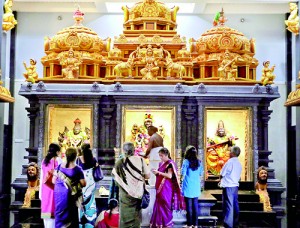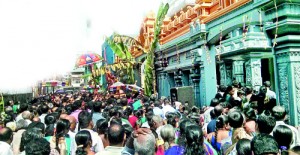The gods find a new home
The first face I see belongs to Lord Ganesh. As is traditional, the Remover of Obstacles greets every devotee who arrives at the newly opened temple in Wellawatte. Inside, three goddesses await but this space is dedicated primarily to one of the eight forms of the goddess Luxshmi – from the benevolent hand of Aishwarya-Luxshmi or Dhana-Lakshmi wealth and prosperity are said to flow. Her imposing likeness, carved into a single block of granite, standing 6ft tall and weighing many tonnes is the focus of the new temple, but there are several elements that distinguish it from other places of worship. Take for instance, the paintings of Lord Buddha, Jesus Christ, Guru Nanak and Mahaveer that claim places of honour on the highest floor.

Devotees inside the temple. Pic by M.A. Pushpa Kumara
The latter mark this new temple as only one of two “philosophical temples” in the world, says Dr. Prassanna Logenthiran, a member of the All Ceylon Kamban Kalagham. The society which celebrates Tamil language and literature has representatives in both Jaffna and Colombo. It was also the driving force behind this project. “This temple is the first philosophical temple in this country,” says Prassanna, explaining that its predecessor, the famous Avudayar Koil, was built in South India in the 8th Century by the poet-saint Swami Manikavasagar (also spelt as Manikkavacakar). Like its ancestor, this new temple too flouts the rules and regulations laid down for the construction and layout of its traditional counterparts. It honours, above all things, the spiritual maturity that ultimately transcends every religion to create a pure union with the divine, says the founder of the Kamban Kalagham, Kambavarithi E. Jeyaraj.
It was always a temple dedicated to Aishwarya-Luxshmi but it began its life as a much smaller place of worship built to celebrate the 25th anniversary of the Kamban Kalagham. Like all such projects it has been supported by the community ever since. Tucked into the corner of a lane off Roxy Gardens in Wellawatte, the new edifice was inaugurated with rituals and invocations, culminating in the temple being declared open on Thai Pongal. (The day was chosen by the goddess herself – she stood watch as the chit with the date on it was drawn.)
The four floors taper – the largest level represents the simplest in spiritual terms where the divine is represented by actual figures. By the time you get to the very top, each section incrementally smaller, there are no more forms. Only the images of the Hindu saints and the great figures from other religions look down on you. (A representative of Islam is soon to be added.) Though it is little known, the committee wanted to make tangible Swami Manikavasagar’s declaration that he bowed down to those who had excelled spiritually outside Hinduism as well.
I saw the temple for the first time on day two of the inauguration celebrations – a three-day extravaganza that began with singing, moved into chanting and culminated in a crescendo of drumming. For many, this was a moment that would come only once or twice in their lives. We came prepared for the ‘ennaikappu’ or anointing ceremony, dressed in garments that we could afford to have stained. Inside the temple the gods waited, a bowl of oil placed before each. These bowls would be refilled many times over the coming hours.

Crowds throng the temple on Thai Pongal Day
We queued up until finally arriving before the god we dipped our fingers in the oil and massaged it in to the stone. As hand after hand touched the god in absolute reverence, the statue changed colour, going from a pale grey to a glistening black. Never again, after this day would devotees be singled out before these statues, actually allowed to touch the divine face and limbs. Rather beautifully, Prassanna describes the process as “giving bliss to the stone.” Over the three days, an estimated 20,000 devotees crammed into the narrow lane, immobilising traffic and shutting the street down.
On the final day, we enter the temple only at the end, kept at bay by the crowds that have thronged to watch Aishwarya-Luxshmi introduced to her new home. A miniature version of the great goddess is taken in a procession around the temple and then brought ceremonially back in. Spontaneous roars from the crowd rise above the frenetic drumming, the clanging bell and the voices of the priests conducting the puja. The very air is charged with belief as the gods are called down to inhabit the stone.
Among the divine faces are those not seen in Sri Lanka before. “In Hinduism we believe there are three goddesses: Durga, Luxshmi and Saraswati who depict valour, wealth and intellect respectively,” says Prassanna. He explains that not only are these goddesses present but among the 17 statues is a 6ft representation of Narasimha. An avatar of the god Vishnu, he is the protector of those in need. With the head of a lion and the body of man, the otherwise ferocious Narasimha is portrayed here in a more relaxed posture with Luxshmi on his lap. There is also a statue of Aiyanar, a guardian deity, flanked by two goddesses on either side. On the next floor is Sri Lanka’s tallest Shiva Linga – 7ft tall, the phallic shape is believed to represent the energy and potentiality of one of Hinduism’s most revered deities.
For the next 24 days, the temple will conduct special pujas and over the course of the year, every major festival in the Hindu calendar will be honoured in its large hall.By the time we leave, the crowd has dispersed – some to the houses opposite where lunch is being served. The temple is emptying, and perhaps it is just my imagination, but the energy and the beauty of the festivities linger. It seems the gods have found a new home.


